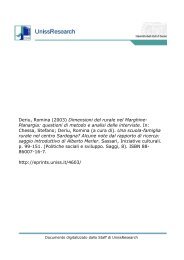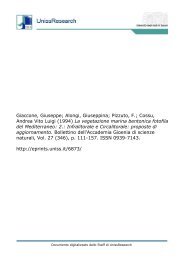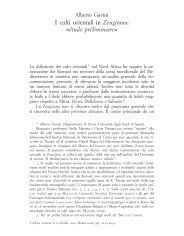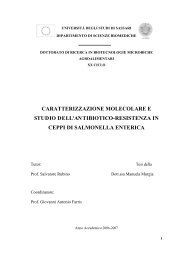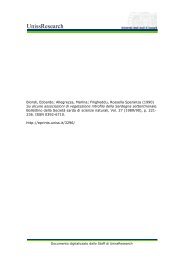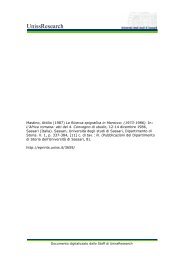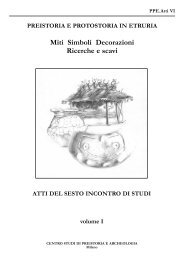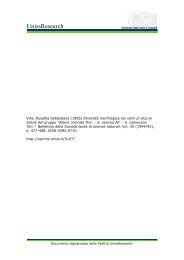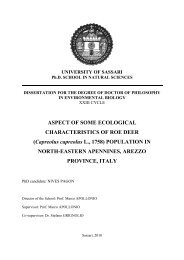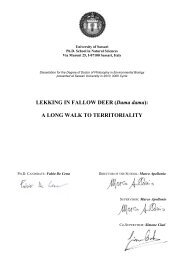Water quality evaluation in Mediterranean lagoons using the ...
Water quality evaluation in Mediterranean lagoons using the ...
Water quality evaluation in Mediterranean lagoons using the ...
Create successful ePaper yourself
Turn your PDF publications into a flip-book with our unique Google optimized e-Paper software.
Transitional <strong>Water</strong>s Bullet<strong>in</strong><br />
TWB, Transit. <strong>Water</strong>s Bull. 7 (2013), n. 1, 64-76<br />
ISSN 1825-229X, DOI 10.1285/i1825229Xv7n1p64<br />
http://siba-ese.unisalento.it<br />
<strong>Water</strong> <strong>quality</strong> <strong>evaluation</strong> <strong>in</strong> <strong>Mediterranean</strong> <strong>lagoons</strong><br />
us<strong>in</strong>g <strong>the</strong> Multimetric Phytoplankton Index (MPI):<br />
Study cases from Sard<strong>in</strong>ia<br />
A.M. Bazzoni 1* , S. Pul<strong>in</strong>a 1 , B.M. Padedda 1 , C.T. Satta 1 , A. Lugliè 1 , N.<br />
Sechi 1 , C. Facca 2<br />
VIEW POINT<br />
1<br />
University of Sassari, Department of Science for Nature and Environmental<br />
Resources, via Piandanna 4, I-07100 Sassari, Italy.<br />
2<br />
University Ca’ Foscari, Department of Environmental Sciences, Informatics<br />
and Statistics, Dorsoduro 2137, I-30121 Venezia, Italy.<br />
*Correspond<strong>in</strong>g author: Phone: +39 079 213042; Fax: +39 079 233600; E-mail<br />
address: bazzoniam@uniss.it.<br />
Abstract<br />
1 - <strong>Water</strong> <strong>quality</strong> <strong>in</strong> four Sard<strong>in</strong>ian <strong>lagoons</strong> (western <strong>Mediterranean</strong> Sea) was assessed us<strong>in</strong>g <strong>the</strong><br />
Multimetric Phytoplankton Index (MPI), which is consistent with <strong>the</strong> EU <strong>Water</strong> Framework Directive.<br />
The <strong>in</strong>dex was developed us<strong>in</strong>g data on phytoplankton abundances, species structure and chlorophyll<br />
a concentrations <strong>in</strong> Venice Lagoon, Italy.<br />
2 - The aim of this study was to test <strong>the</strong> MPI on a larger geographical scale and across a range of lagoon<br />
types. Therefore, it was applied to assess water <strong>quality</strong> <strong>in</strong> <strong>the</strong> Cabras, S’Ena Arrubia, Santa Giusta<br />
and Calich <strong>lagoons</strong> <strong>in</strong> Sard<strong>in</strong>ia. These <strong>lagoons</strong> are all “choked”, but exhibit a range of sizes and<br />
morphometric features. They are directly affected by human activity with<strong>in</strong> <strong>the</strong> <strong>lagoons</strong> <strong>the</strong>mselves,<br />
such as fisheries, aquaculture and <strong>the</strong> construction of dams and canals, and are <strong>in</strong>directly affected<br />
by anthropogenic activities <strong>in</strong> <strong>the</strong>ir catchments, <strong>in</strong>clud<strong>in</strong>g <strong>in</strong>tensive agriculture, <strong>in</strong>dustrial activity<br />
and urban development.<br />
3 - The data used <strong>in</strong> <strong>the</strong> present study were collected monthly over a period of 4 years (Calich, Santa<br />
Giusta and S’Ena Arrubia) to 7 years (Cabras). Samples were collected at three stations at each of <strong>the</strong><br />
Cabras, Santa Giusta and Calich <strong>lagoons</strong>, and at two stations at <strong>the</strong> S’Ena Arrubia Lagoon, provid<strong>in</strong>g<br />
a total of 220 samples.<br />
4 - The water <strong>quality</strong> <strong>in</strong> three of <strong>the</strong> four <strong>lagoons</strong> <strong>in</strong>vestigated (Cabras, S’Ena Arrubia and Calich) was<br />
classified as bad us<strong>in</strong>g <strong>the</strong> MPI. Among <strong>the</strong>se three, water <strong>in</strong> Cabras Lagoon exhibited <strong>the</strong> worst<br />
condition. <strong>Water</strong> <strong>quality</strong> <strong>in</strong> Santa Giusta Lagoon was classified as poor us<strong>in</strong>g <strong>the</strong> MPI.<br />
5 - Although we present prelim<strong>in</strong>ary results that require fur<strong>the</strong>r verification, <strong>the</strong> <strong>in</strong>dex appears to be a<br />
useful tool for assess<strong>in</strong>g <strong>the</strong> ecological status of typical <strong>Mediterranean</strong> <strong>lagoons</strong>.<br />
Keywords: Biological <strong>in</strong>dex, Phytoplankton, <strong>Water</strong> Framework Directive, <strong>Mediterranean</strong> <strong>lagoons</strong>, Sard<strong>in</strong>ia.<br />
Introduction<br />
The EU <strong>Water</strong> Framework Directive<br />
(WFD; 2000/60/EC) is <strong>the</strong> legal <strong>in</strong>strument<br />
aimed at ma<strong>in</strong>ta<strong>in</strong><strong>in</strong>g and improv<strong>in</strong>g <strong>the</strong><br />
ecological <strong>quality</strong> of fresh and coastal waters<br />
throughout <strong>the</strong> European Community. It<br />
requires assessment of <strong>the</strong> <strong>quality</strong> of water<br />
bodies based on biological elements <strong>in</strong><br />
comparison with reference conditions. For<br />
each ecosystem type, <strong>the</strong> requirements for a<br />
© 2013 University of Salento - SIBA http://siba-ese.unisalento.it
TWB 7 (2013), n. 1<br />
Application of MPI for Sard<strong>in</strong>ian <strong>lagoons</strong><br />
given ecological status under <strong>the</strong> WFD vary<br />
on regional, national and European scales.<br />
This has resulted <strong>in</strong> <strong>the</strong> implementation of a<br />
multitude of methods and multimetric <strong>in</strong>dices<br />
for ecological <strong>evaluation</strong> (Birk et al., 2012).<br />
In Italy, <strong>the</strong> sampl<strong>in</strong>g protocol for<br />
transitional waters is described <strong>in</strong> <strong>the</strong> El-<br />
Pr-TW-Monitor<strong>in</strong>g Protocol-03.06 (Italian<br />
M<strong>in</strong>isterial Decree 56/2009; ISPRA, 2011).<br />
However, only <strong>the</strong> use of <strong>the</strong> Macrophyte<br />
Quality Index (MaQI; Sfriso et al., 2009;<br />
ISPRA, 2010) and Multivariate Mar<strong>in</strong>e<br />
Biotic Index (M-AMBI; Muxika et al.,<br />
2007) for macrozoobenthos are currently<br />
mandatory under national law (Italian<br />
M<strong>in</strong>isterial Decree 260/2010). The use of<br />
<strong>the</strong> Benthic Index based on Taxonomic<br />
Sufficiency (BITS; Mistri and Munari,<br />
2008) for assess<strong>in</strong>g macro<strong>in</strong>vertebrates is<br />
optional. The Italian M<strong>in</strong>isterial Decree<br />
260/2010 does not provide at <strong>the</strong> moment<br />
any <strong>in</strong>dices assess<strong>in</strong>g phytoplankton and<br />
fishes, even if <strong>the</strong>y are among <strong>the</strong> biological<br />
<strong>quality</strong> elements required by <strong>the</strong> WFD to<br />
<strong>the</strong> ecological classification of transitional<br />
waters.<br />
In <strong>Mediterranean</strong> <strong>lagoons</strong>, macrophytes<br />
often surpass phytoplankton as <strong>the</strong> most<br />
important primary producers (Giordani et al.,<br />
2005; Souchu et al., 2010). In <strong>the</strong>se cases,<br />
<strong>the</strong> role of phytoplankton only becomes<br />
relevant <strong>in</strong> periods when macrophytes<br />
are absent. Never<strong>the</strong>less, <strong>in</strong> a number<br />
of <strong>lagoons</strong>, phytoplankton is <strong>the</strong> sole or<br />
prevalent primary producer throughout <strong>the</strong><br />
year. In <strong>the</strong>se cases, phytoplankton is a<br />
powerful <strong>in</strong>dicator of trophic conditions due<br />
to <strong>the</strong>ir ability to respond to environmental<br />
changes, particularly nutrient enrichment.<br />
Consequently, phytoplankton is considered<br />
to be one of <strong>the</strong> most useful biotic elements<br />
for assess<strong>in</strong>g <strong>the</strong> environmental <strong>quality</strong> of<br />
water bodies <strong>in</strong> which eutrophy presents a<br />
major environmental issue (Tremel, 1996;<br />
Brettum and Andersen, 2005).<br />
Several methods for classification of<br />
transitional waters based on phytoplankton<br />
data have been proposed (Facca and Sfriso,<br />
2009; Borja et al., 2013; Lugoli et al., 2012).<br />
However, <strong>the</strong>se require metrics that are not<br />
rout<strong>in</strong>ely collected by local authorities (e.g.,<br />
biovolumes or cell sizes), and are <strong>the</strong>refore<br />
unable to be used to determ<strong>in</strong>e an official<br />
classification (Italian M<strong>in</strong>isterial Decree<br />
260/2010). To resolve this issue and to meet<br />
<strong>the</strong> WFD requirements, <strong>the</strong> Multimetric<br />
Phytoplankton Index (MPI; Facca et al.,<br />
2011) was developed for classification of<br />
<strong>the</strong> environmental <strong>quality</strong> of transitional<br />
water bodies <strong>in</strong> Italy. The <strong>in</strong>dex was<br />
developed us<strong>in</strong>g data on phytoplankton<br />
abundance, species structure and chlorophyll<br />
a concentration <strong>in</strong> Venice Lagoon, Italy.<br />
The MPI is easy to calculate, and it is<br />
based on approved methods and parameters<br />
often regularly collected by most of local<br />
agencies and mar<strong>in</strong>e scientific <strong>in</strong>stitutions.<br />
It derives from <strong>the</strong> complete description<br />
of phytoplankton community (diversity,<br />
abundance, dom<strong>in</strong>ance) and so it can give<br />
<strong>in</strong>dications on both trophic and ecological<br />
conditions. The ma<strong>in</strong> drawback is <strong>the</strong> high<br />
level of taxonomic def<strong>in</strong>ition required; this<br />
needs both a great experience of <strong>the</strong> operators<br />
<strong>in</strong> <strong>the</strong> correct identification of species and<br />
additional efforts <strong>in</strong> <strong>in</strong>tercalibration process,<br />
with<strong>in</strong> and between laboratories.<br />
Validation of this wide-rang<strong>in</strong>g <strong>in</strong>dex is still<br />
<strong>in</strong> progress, but results obta<strong>in</strong>ed from o<strong>the</strong>r<br />
<strong>lagoons</strong> suggest that it is a useful <strong>in</strong>dicator<br />
of water <strong>quality</strong> (Bazzoni et al., 2012; Facca<br />
et al., 2012).<br />
With <strong>the</strong> aim to verify <strong>the</strong> reliability of MPI<br />
and to test <strong>the</strong> <strong>in</strong>dex on a larger geographical<br />
scale, consider<strong>in</strong>g a major number of study<br />
cases and typology of <strong>lagoons</strong>, it was applied<br />
to four Sard<strong>in</strong>ian <strong>lagoons</strong>: Cabras, S’Ena<br />
Arrubia, Santa Giusta and Calich. These<br />
<strong>lagoons</strong> belong to <strong>the</strong> <strong>Mediterranean</strong> climate<br />
typology (Basset et al., 2006; Tagliapietra and<br />
Volpi Ghirard<strong>in</strong>i, 2006) and are characterized<br />
by remarkable differences <strong>in</strong> morphology,<br />
© 2013 University of Salento - SIBA http://siba-ese.unisalento.it 65
TWB 7 (2013), n. 1<br />
A.M. Bazzoni, S. Pul<strong>in</strong>a, B.M. Padedda, C.T. Satta, A. Lugliè, N. Sechi, C. Facca<br />
environmental conditions and human impacts<br />
and, thanks to <strong>the</strong> availability of long-term<br />
data, were considered <strong>in</strong>terest<strong>in</strong>g study cases<br />
for <strong>the</strong> application of <strong>the</strong> MPI.<br />
Materials and Methods<br />
Study sites<br />
Sard<strong>in</strong>ia is <strong>the</strong> second largest <strong>Mediterranean</strong><br />
island. It conta<strong>in</strong>s many transitional<br />
ecosystems, which cover a total area of<br />
approximately 10,000 ha, and constitute<br />
2.6% of all <strong>lagoons</strong> <strong>in</strong> Italy (Cottiglia, 1981).<br />
Fish<strong>in</strong>g and aquaculture <strong>in</strong> <strong>the</strong> Sard<strong>in</strong>ian<br />
<strong>lagoons</strong> make <strong>the</strong>m important to <strong>the</strong> local<br />
and regional economies. In <strong>the</strong> last century,<br />
Sard<strong>in</strong>ian <strong>lagoons</strong> and wetlands were<br />
extensively reclaimed for a variety of human<br />
uses. These actions have led to profound<br />
changes <strong>in</strong> <strong>the</strong> hydrological conditions of <strong>the</strong><br />
<strong>lagoons</strong>. Fur<strong>the</strong>rmore, <strong>in</strong>creased <strong>in</strong>dustrial<br />
activity, agriculture and urban discharge<br />
have deeply modified <strong>the</strong> natural equilibrium<br />
of <strong>the</strong>se ecosystems. Cannas et al. (1998)<br />
reported that approximately 50% of Sard<strong>in</strong>ian<br />
<strong>lagoons</strong> are eutrophic.<br />
The four <strong>lagoons</strong> considered here are all<br />
located on <strong>the</strong> western coast of Sard<strong>in</strong>ia.<br />
Calich (CL) is situated on <strong>the</strong> nor<strong>the</strong>rn part of<br />
<strong>the</strong> coast, whereas Cabras (CB), Santa Giusta<br />
(SG) and S’Ena Arrubia (SA) are located <strong>in</strong><br />
<strong>the</strong> central part, connected to <strong>the</strong> Gulf of<br />
Oristano (Fig. 1). The latter three sites are<br />
research stations <strong>in</strong>cluded <strong>in</strong> <strong>the</strong> ‘Mar<strong>in</strong>e<br />
Ecosystems of Sard<strong>in</strong>ia’, part of <strong>the</strong> Italian<br />
Network of Long-Term Ecological Research<br />
(LTER-Italia; http://www.lteritalia.it).<br />
The <strong>lagoons</strong> <strong>in</strong> this study are all ‘choked’<br />
sensu Kjerfve (1986), but display significant<br />
Figure 1. Map show<strong>in</strong>g <strong>the</strong> locations of <strong>the</strong> four <strong>lagoons</strong> considered here.<br />
© 2013 University of Salento - SIBA http://siba-ese.unisalento.it 66
TWB 7 (2013), n. 1<br />
Application of MPI for Sard<strong>in</strong>ian <strong>lagoons</strong><br />
variation <strong>in</strong> several morphological features.<br />
For example, CL and SA are among <strong>the</strong><br />
smaller Sard<strong>in</strong>ian <strong>lagoons</strong>, whereas CB and<br />
SG are among <strong>the</strong> larger. Mean water depth<br />
also varies markedly among <strong>the</strong> four <strong>lagoons</strong><br />
(Table 1). The characteristics of water <strong>in</strong> <strong>the</strong><br />
<strong>lagoons</strong> are def<strong>in</strong>ed by <strong>the</strong> extent of water<br />
exchange with <strong>the</strong> sea, and <strong>the</strong> amount of<br />
freshwater <strong>in</strong>flow from catchments. As a<br />
result, CL and CB are meso-polyhal<strong>in</strong>e,<br />
compared with SG and SA, which are mar<strong>in</strong>e<br />
<strong>lagoons</strong>.<br />
All <strong>the</strong> ecosystems <strong>in</strong> this study range from<br />
eutrophic to hypereutrophic, and show large<br />
seasonal variations <strong>in</strong> nutrient concentration.<br />
This is a result of polluted <strong>in</strong>puts from <strong>the</strong><br />
respective watersheds, which is largely a<br />
consequence of <strong>in</strong>adequate purification of<br />
urban and agricultural wastewater. Dystrophic<br />
crises, frequently associated with microalgal<br />
blooms, can occur dur<strong>in</strong>g summer, lead<strong>in</strong>g to<br />
extensive fish mortality (e.g., CB <strong>in</strong> 1999,<br />
SG <strong>in</strong> 1989 and 2010, and several episodes<br />
<strong>in</strong> SA from 1960 onwards; Sechi et al.,<br />
2001; Treb<strong>in</strong>i et al., 2005). CB is typically<br />
dom<strong>in</strong>ated by phytoplankton, whereas SG,<br />
SA and CL also support macrophyte growth<br />
dur<strong>in</strong>g spr<strong>in</strong>g–early summer (Treb<strong>in</strong>i et<br />
al., 2005; Ceccherelli et al., 2009). The<br />
<strong>lagoons</strong> are protected by several national<br />
and <strong>in</strong>ternational agreements due to <strong>the</strong>ir<br />
value as natural resources (e.g., <strong>the</strong> Ramsar<br />
Convention, European SCI and SPA, and<br />
local and regional parks).<br />
Data sources<br />
We derived datasets from data collected<br />
monthly over a range of 4 years (CL, SG<br />
and SA) to 7 years (CB, Table 2). These data<br />
were collected at two stations <strong>in</strong> SA, and at<br />
three stations <strong>in</strong> CL, SG and CB.<br />
<strong>Water</strong> samples, collected from <strong>the</strong> superficial<br />
water layer (30-50 cm depth), were considered<br />
as representative of <strong>the</strong> entire water column<br />
Table 1 - Morphological features of <strong>the</strong> four <strong>lagoons</strong> studied.<br />
1<br />
Sites<br />
Calich Cabras Santa Giusta S’Ena Arrubia<br />
Code CL CB SG SA<br />
Latitude 40.55 N 39.94 N 39.86 N 39.82 N<br />
Longitude 8.18 E 8.48 E 8.59 E 8.56 E<br />
Lagoon Area (km 2 ) 0.87 27.8 8.02 1.2<br />
Catchment Area (km 2 ) 432 436 173 128<br />
Mean depth (m) 1.5 1.5 1 0.4<br />
Max depth (m) 3.5 3 1.2 0.6<br />
Number of <strong>in</strong>lets 3 2 2 3<br />
<strong>Water</strong> <strong>in</strong>put (10 6 x m 3 y -1 ) 28.6 80.2 38.5 28.8<br />
Residence times (d) 8 191 43 6<br />
Number of outlets 1<br />
4 narrow creeks + (1 wide<br />
channel with only<br />
2 1<br />
discharge)<br />
Total outlets width (m) 55 50 + (200) 90 35<br />
Tidal regime (m)<br />
nanotidal,<br />
TWB 7 (2013), n. 1<br />
A.M. Bazzoni, S. Pul<strong>in</strong>a, B.M. Padedda, C.T. Satta, A. Lugliè, N. Sechi, C. Facca<br />
Table 2 - Mean annual dissolved <strong>in</strong>organic nitrogen (DIN) and orthophosphates (P-PO4) concentrations <strong>in</strong><br />
<strong>the</strong> four <strong>lagoons</strong>. Values exceed<strong>in</strong>g <strong>the</strong> threshold values established by Italian law (DIN > 25 µM and P-PO4<br />
> 0.8 µM) are shown <strong>in</strong> bold.<br />
Site<br />
CL<br />
CB<br />
SG<br />
SA<br />
Annual<br />
cycles<br />
I<br />
II<br />
III<br />
IV<br />
I<br />
II<br />
III<br />
IV<br />
V<br />
VI<br />
VII<br />
I<br />
II<br />
III<br />
IV<br />
I<br />
II<br />
III<br />
IV<br />
DIN (µM)<br />
P-PO4 (µM)<br />
St.1 St.2 St.3 Mean St.1 St.2 St.3 Mean<br />
69.6 73.1 35.4 59.4 1.45 1.93 1.27 1.6<br />
50.4 78.6 37.1 55.4 1.25 2.44 1.24 1.6<br />
72.9 87 55.2 71.7 2.02 2.44 2.01 2.2<br />
77.5 104 82.5 88.0 2.78 3.64 2.92 3.1<br />
123 143 249 171.7 0.77 1.67 5.69 2.7<br />
13.2 4.06 6.45 7.9 1.44 1.63 2.34 1.8<br />
6.82 5.84 8.97 7.2 0.72 0.82 1.07 0.9<br />
8.12 7.11 9.08 8.1 1.23 1.01 1.24 1.2<br />
4.15 3.16 4.33 3.9 0.54 0.55 0.87 0.7<br />
10.8 8.69 17.5 12.3 0.57 0.6 0.88 0.7<br />
11.3 8.29 26 15.2 0.37 0.31 2.68 1.1<br />
4.24 2.88 3.84 3.7 2.94 2.55 2.88 2.8<br />
9.65 7.46 30.64 15.9 2.72 2.82 4.92 3.5<br />
5.66 1.69 3.81 3.7 2.95 2.44 3 2.8<br />
11.8 9.29 8.76 10.0 1.88 1.67 2.05 1.9<br />
10 13.4 11.7 3.8 5.06 n.a. 4.4<br />
5.73 6.72 n.a. 6.2 4.69 5.22 n.a. 5.0<br />
11.6 25.1 n.a. 18.4 3.91 6.38 n.a. 5.1<br />
26.4 18.7 n.a. 22.6 4.97 4.73 n.a. 4.9<br />
due to <strong>the</strong> shallowness and <strong>the</strong> well mixed<br />
regime of <strong>the</strong> <strong>lagoons</strong>. Temperature, sal<strong>in</strong>ity,<br />
dissolved oxygen and pH were measured <strong>in</strong><br />
situ with a multi-parameter probe (Idronaut<br />
and YSI 6600V2). Samples were preserved<br />
<strong>in</strong> cold and dark conditions for laboratory<br />
analyses of nutrients (ammonia, nitrate,<br />
nitrite, reactive silica, orthophosphates and<br />
total phosphorus) follow<strong>in</strong>g Strickland and<br />
Parsons (1972), and for chlorophyll a (SCOR-<br />
UNESCO, 1997). Dissolved <strong>in</strong>organic<br />
nitrogen (DIN) was obta<strong>in</strong>ed as <strong>the</strong> sum of<br />
ammonia, nitrate and nitrite.<br />
Phytoplankton samples were fixed with<br />
Lugol’s solution or buffered formal<strong>in</strong>e<br />
solution at a f<strong>in</strong>al concentration of 4% and<br />
analysed accord<strong>in</strong>g to <strong>the</strong> Utermöhl technique<br />
(1958).<br />
<strong>Water</strong> Quality Index<br />
The complete procedure for apply<strong>in</strong>g <strong>the</strong><br />
MPI was previously described by Facca et al.<br />
(2011, submitted) and Bazzoni et al. (2012).<br />
Shortly, calculation of <strong>the</strong> <strong>in</strong>dex requires <strong>the</strong><br />
© 2013 University of Salento - SIBA http://siba-ese.unisalento.it 68
TWB 7 (2013), n. 1<br />
Application of MPI for Sard<strong>in</strong>ian <strong>lagoons</strong><br />
follow<strong>in</strong>g four metrics to be calculated:<br />
- 100-Hulburt <strong>in</strong>dex: <strong>the</strong> dom<strong>in</strong>ance of <strong>the</strong><br />
two most abundant species (Hulburt’s <strong>in</strong>dex;<br />
Hulburt, 1963);<br />
- 100-Bloom Frequency: <strong>the</strong> frequency at<br />
which <strong>the</strong> most abundant species accounted<br />
for >50% of organisms at each station (bloom<br />
frequency);<br />
- Menh<strong>in</strong>ick’s diversity <strong>in</strong>dex (Menh<strong>in</strong>ick,<br />
1964): this <strong>in</strong>dex evaluates environmental<br />
stress, as reduction of species diversity<br />
with<strong>in</strong> a community is generally <strong>in</strong>dicative<br />
of natural or anthropogenic alteration;<br />
- <strong>the</strong> geometric mean of chlorophyll a,<br />
calculated with log-transformed chlorophyll<br />
values. Antilog transformations are <strong>the</strong>n<br />
required to calculate <strong>the</strong> MPI.<br />
To calculate each metric, we only considered<br />
microalgae at genus or specie level. We<br />
averaged values at each station over a 1-year<br />
period to reduce seasonal variability.<br />
Here, <strong>the</strong> ecological <strong>quality</strong> ratio (EQR)<br />
is def<strong>in</strong>ed as <strong>the</strong> ratio between <strong>the</strong> metrics<br />
calculated for <strong>the</strong> four Sard<strong>in</strong>ian <strong>lagoons</strong> and<br />
<strong>the</strong> reference conditions (Facca and Sfriso,<br />
2009; Facca et al., 2011), <strong>in</strong>dividuated <strong>in</strong><br />
an area of <strong>the</strong> LTER site Venice Lagoon and<br />
characterized by a low anthropogenic pressure<br />
and by a few direct <strong>in</strong>puts of pollutants.<br />
The EQR calculated varied between 0 and<br />
1. Values used <strong>in</strong> <strong>the</strong> MPI correspond to<br />
<strong>the</strong> mean of <strong>the</strong> four EQRs. To attribute<br />
each station and each lagoon to a def<strong>in</strong>ed<br />
ecological <strong>quality</strong> class, five equal <strong>in</strong>tervals<br />
of <strong>the</strong> MPI were used, follow<strong>in</strong>g <strong>the</strong> WFD:<br />
0.00–0.20 (bad), 0.21–0.40 (poor), 0.41–0.60<br />
(moderate), 0.61–0.80 (good) and 0.81–1.00<br />
(high).<br />
Statistical analyses<br />
A Pearson correlation matrix was generated<br />
us<strong>in</strong>g <strong>the</strong> mean annual values for each lagoon<br />
to assess <strong>the</strong> relationship between MPI<br />
scores and nutrient concentrations; p-values<br />
< 0.05 were considered significant. Pr<strong>in</strong>cipal<br />
component analysis (PCA) was performed<br />
to highlight <strong>the</strong> system variance <strong>in</strong> relation<br />
to environmental variables and <strong>the</strong> MPI. For<br />
this calculation, our datasets were <strong>in</strong>tegrated<br />
with <strong>the</strong> data collected at <strong>the</strong> reference site<br />
(Facca and Sfriso, 2009). This ensured that<br />
a range of nutrient concentrations and all<br />
<strong>quality</strong> classes were represented. Sal<strong>in</strong>ity<br />
(S), DIN and orthophosphates (P-PO4) were<br />
considered for each of <strong>the</strong> <strong>lagoons</strong>. In addition,<br />
dissolved oxygen (Ox) and reactive silica<br />
(Si) were used for CL and CB. Consequently,<br />
we performed two different calculations to<br />
demonstrate <strong>the</strong> correlation between <strong>the</strong> MPI<br />
and environmental variables. All statistical<br />
analyses were carried out us<strong>in</strong>g Statistica 7.1<br />
(Statsoft Italia srl).<br />
Results<br />
Nutrients and phytoplankton<br />
Nutrient values were high <strong>in</strong> all <strong>the</strong> <strong>lagoons</strong><br />
<strong>in</strong> <strong>the</strong> annual cycles (Table 2). Mean annual<br />
DIN values were 3.7–15.9 µM <strong>in</strong> SG, 6.2–<br />
22.6 µM <strong>in</strong> SA, 3.9–171.7 µM <strong>in</strong> CB, and<br />
55.4–88.0 µM <strong>in</strong> CL. Mean annual P-PO4<br />
values were 0.7–2.7 µM <strong>in</strong> CB, 1.6–3.1 µM<br />
<strong>in</strong> CL, 1.9–3.5 µM <strong>in</strong> SG, and 4.4–5.1 µM <strong>in</strong><br />
SA.<br />
The complete dataset comprised 233<br />
phytoplankton taxa. Despite <strong>the</strong> different<br />
number of annual cycles considered at each<br />
location, <strong>the</strong> <strong>lagoons</strong> all supported a similar<br />
number of taxa, with <strong>the</strong> m<strong>in</strong>imum (96) <strong>in</strong> SA<br />
and <strong>the</strong> maximum (114) <strong>in</strong> CL.<br />
The mean annual value of phytoplankton cell<br />
density varied from 2 × 10 6 cells l –1 <strong>in</strong> SG to<br />
approximately 5 × 10 9 cells l –1 <strong>in</strong> CB (Table 3).<br />
In general, phytoplankton abundance was<br />
lowest <strong>in</strong> SG, moderate <strong>in</strong> SA and CL,<br />
and highest <strong>in</strong> CB. A clear dom<strong>in</strong>ance<br />
of Bacillariophyceae and Cyanobacteria<br />
was observed <strong>in</strong> CB (Fig. 2). The relative<br />
importance of phytoplankton classes varied<br />
widely <strong>in</strong> SA and SG, with Chlorophyceae<br />
and Bacillariophyceae much more abundant<br />
than o<strong>the</strong>r classes <strong>in</strong> certa<strong>in</strong> annual cycles<br />
(Fig. 2). In CL, Bacillariophyceae were <strong>the</strong><br />
© 2013 University of Salento - SIBA http://siba-ese.unisalento.it 69
TWB 7 (2013), n. 1<br />
A.M. Bazzoni, S. Pul<strong>in</strong>a, B.M. Padedda, C.T. Satta, A. Lugliè, N. Sechi, C. Facca<br />
Table 3 -Annual means of cell densities and chlorophyll a concentration <strong>in</strong> <strong>the</strong> four studied <strong>lagoons</strong>.<br />
Site<br />
CL<br />
CB<br />
SG<br />
SA<br />
Annual<br />
cycles<br />
Cell Densities (10 6 cells l -1 ) Chlorophyll a (µg l -1 )<br />
St.1 St.2 St.3 Mean St.1 St.2 St.3 Mean<br />
I 11 5 7 8 11 10 14 12<br />
II 47 46 62 52 21 23 23 22<br />
III 51 56 47 51 13 13 11 12<br />
IV 30 32 27 29 7 9 11 9<br />
I 56 80 28 55 130 148 146 141<br />
II 27 34 26 29 55 48 53 52<br />
III 36 53 34 41 37 38 42 39<br />
IV 3603 4838 6547 4996 32 36 63 44<br />
V 1186 1195 1357 1246 23 18 22 21<br />
VI 2519 2496 2839 2618 12 14 16 14<br />
VII 526 663 683 624 112 112 122 115<br />
I 86 87 84 85 18 15 24 19<br />
II 7 1 8 5 14 5 12 10<br />
III 2 3 6 4 6 8 10 8<br />
IV 1 4 2 2 9 6 12 9<br />
I 16 17 n.a. 17 14 11 n.a 12<br />
II 17 22 n.a. 20 6 9 n.a 7<br />
III 17 20 n.a. 18 35 61 n.a 48<br />
IV 15 8 n.a. 12 23 18 n.a 20<br />
dom<strong>in</strong>ant class <strong>in</strong> all annual cycles, with<br />
D<strong>in</strong>ophyceae and o<strong>the</strong>r classes (ma<strong>in</strong>ly<br />
Cryptophyceae) also contribut<strong>in</strong>g (Fig. 2).<br />
Mean annual values of chlorophyll a were<br />
8–19 µg l –1 <strong>in</strong> SG, 9–22 µg l –1 <strong>in</strong> CL, 7–48<br />
µg l –1 <strong>in</strong> SA, and 14–141 µg l –1 <strong>in</strong> CB (Table<br />
3). Overall, <strong>the</strong> highest chlorophyll a values<br />
were consistently recorded <strong>in</strong> CB, with levels<br />
up to five times higher than <strong>the</strong> o<strong>the</strong>r <strong>lagoons</strong>.<br />
Application of <strong>the</strong> MPI<br />
The data regard<strong>in</strong>g phytoplankton assemblage<br />
composition and cell abundance allowed<br />
us to apply <strong>the</strong> MPI by calculat<strong>in</strong>g <strong>the</strong> four<br />
necessary metrics for each lagoon (Table 4).<br />
The mean value of 100-Hulburt <strong>in</strong>dex for<br />
<strong>the</strong> <strong>lagoons</strong> was lowest <strong>in</strong> SA and CB (6.36<br />
and 6.76, respectively), moderate <strong>in</strong> CL<br />
(9.44), and highest <strong>in</strong> SG (15.65). The widest<br />
range among stations with<strong>in</strong> one lagoon was<br />
observed <strong>in</strong> CL (6.47–11.26), whereas <strong>in</strong>dex<br />
values were relatively consistent between<br />
stations <strong>in</strong> <strong>the</strong> o<strong>the</strong>r <strong>lagoons</strong>.<br />
The mean of 100-Bloom Frequency varied<br />
from a m<strong>in</strong>imum of 1.39 <strong>in</strong> SA, to higher<br />
values <strong>in</strong> CB (10.35) and CL (13.56), and<br />
reached a maximum of 32.79 <strong>in</strong> SG (Table 4).<br />
Similarly, Menh<strong>in</strong>ick’s diversity <strong>in</strong>dex was<br />
lowest <strong>in</strong> CB (0.001) and highest <strong>in</strong> SG (0.015;<br />
Table 4). The geometric mean of chlorophyll<br />
a varied from 8.51 to 65.7 µg l –1 , measured<br />
<strong>in</strong> SG and CB, respectively (Table 4).<br />
To accurately assess <strong>the</strong> ecological status of<br />
transitional water, comparison with a nearprist<strong>in</strong>e<br />
reference site is necessary. The MPI<br />
showed a generally homogeneous situation<br />
with<strong>in</strong> each lagoon (Fig. 3). The MPI value<br />
<strong>in</strong>dicated a bad condition <strong>in</strong> CL and CB<br />
(Table 5), and a poor condition <strong>in</strong> SG. SA<br />
was <strong>the</strong> only lagoon that demonstrated a<br />
difference <strong>in</strong> water <strong>quality</strong> across stations:<br />
bad at Station 1, closer to <strong>the</strong> sea and poor<br />
© 2013 University of Salento - SIBA http://siba-ese.unisalento.it 70
TWB 7 (2013), n. 1<br />
Application of MPI for Sard<strong>in</strong>ian <strong>lagoons</strong><br />
Figure 2. Mean annual density of phytoplankton classes <strong>in</strong> <strong>the</strong> four <strong>lagoons</strong> studied.<br />
at Station 2 (Fig. 3). However, <strong>the</strong> average<br />
condition of SA rema<strong>in</strong>s bad (MPI = 0.18),<br />
similar to CL and CB.<br />
Statistical analyses<br />
The statistical analyses supported <strong>the</strong><br />
conclusion that <strong>the</strong> MPI is suitable for<br />
assess<strong>in</strong>g ecological water <strong>quality</strong>, as <strong>the</strong>re<br />
was a significant <strong>in</strong>verse correlation (p-value<br />
< 0.05) between <strong>the</strong> MPI and P-PO4 content.<br />
Moreover, <strong>the</strong> MPI was positively correlated<br />
with sal<strong>in</strong>ity. Such relationships are better<br />
depicted by <strong>the</strong> PCA <strong>in</strong> Fig. 4a. The first two<br />
components account for almost 80% of <strong>the</strong><br />
system variance, and are <strong>the</strong>refore strong<br />
<strong>in</strong>dicators of environmental conditions.<br />
In CL and CB, data regard<strong>in</strong>g oxygen<br />
saturation and silicate concentration were<br />
also available. It was <strong>the</strong>refore possible to<br />
verify that MPI was directly correlated with<br />
conditions oversaturated with oxygen (Fig.<br />
4b). Where such conditions existed, <strong>the</strong> MPI<br />
also showed a significant correlation with<br />
DIN, probably because CL was particularly<br />
rich <strong>in</strong> nitrogen compounds.<br />
Discussion<br />
It has already been observed that phytoplankton<br />
can provide important <strong>in</strong>formation on <strong>the</strong><br />
ecosystem status (Facca and Sfriso, 2009). In<br />
our study, <strong>the</strong> application of an <strong>in</strong>dex based<br />
on phytoplankton variables, <strong>the</strong> MPI, to four<br />
© 2013 University of Salento - SIBA http://siba-ese.unisalento.it 71
TWB 7 (2013), n. 1<br />
A.M. Bazzoni, S. Pul<strong>in</strong>a, B.M. Padedda, C.T. Satta, A. Lugliè, N. Sechi, C. Facca<br />
Table 4. Multiannual means of phytoplankton metrics calculated accord<strong>in</strong>g to Facca et al. (2011) and Bazzoni et al. (2012).<br />
CL CB SA SG<br />
c<br />
St.1 St.2 St.3 mean St.1 St.2 St.3 mean St.1 St.2 mean St.1 St.2 St.3 mean<br />
100-Hulburt (%) 10.59 11.26 6.47 9.44 5.22 6.37 8.68 6.76 5.93 6.79 6.36 14.64 15.33 16.98 15.65<br />
100-Bloom Frequency (%) 21.82 14.32 4.55 13.56 12.35 8.89 9.82 10.35 0.00 2.78 1.39 32.09 24.15 42.12 32.79<br />
Menh<strong>in</strong>ick Index 0.005 0.005 0.004 0.005 0.001 0.001 0.002 0.001 0.009 0.016 0.013 0.015 0.015 0.013 0.014<br />
Chlorophyll a (µg l -1 ) 13.20 14.27 15.56 14.34 57.08 58.82 65.71 60.54 19.21 24.44 21.83 11.69 8.51 14.29 11.50<br />
<strong>Mediterranean</strong> <strong>lagoons</strong> <strong>in</strong>dicated for all a<br />
critical state of <strong>the</strong>ir water <strong>quality</strong>.<br />
It was supported by <strong>the</strong> results of <strong>the</strong><br />
statistical analysis, and was coherent with<br />
that reported <strong>in</strong> previous studies (Lugliè et<br />
al., 2001; Sechi et al., 2001; Treb<strong>in</strong>i et al.,<br />
2005; Pul<strong>in</strong>a et al., 2011, 2012; Padedda et<br />
al., 2012).<br />
CL showed <strong>the</strong> highest DIN concentration,<br />
except <strong>in</strong> 1999 when a strong dystrophic<br />
event occurred <strong>in</strong> CB, whereas SA showed<br />
highest P-PO4 values. CL and SA were <strong>the</strong><br />
smaller <strong>lagoons</strong> considered <strong>in</strong> <strong>the</strong> present<br />
study, but <strong>the</strong> former has a dra<strong>in</strong>age bas<strong>in</strong><br />
of similar area to CB, <strong>the</strong> largest lagoon,<br />
whereas a large part of <strong>the</strong> catchment<br />
area of SA is used for <strong>in</strong>tensive arable<br />
agriculture and cattle breed<strong>in</strong>g. Regard<strong>in</strong>g<br />
SA, it is important to po<strong>in</strong>t out that <strong>the</strong><br />
bad condition likely occurred because <strong>the</strong><br />
data were collected before 2000, when an<br />
important ‘reframe’ widened <strong>the</strong> mouth of<br />
<strong>the</strong> canal. This widen<strong>in</strong>g was implemented<br />
with <strong>the</strong> aim of reduc<strong>in</strong>g <strong>the</strong> trophic level of<br />
<strong>the</strong> lagoon by improv<strong>in</strong>g tidal flush<strong>in</strong>g and<br />
lagoon hydrodynamics (Treb<strong>in</strong>i et al., 2005).<br />
Moreover, <strong>the</strong> MPI was positively correlated<br />
with sal<strong>in</strong>ity, <strong>in</strong>dicat<strong>in</strong>g that improved<br />
conditions existed <strong>in</strong> areas located far<strong>the</strong>st<br />
from sites of freshwater <strong>in</strong>put and, <strong>in</strong> <strong>the</strong><br />
case of SA, it reflected on <strong>the</strong> different water<br />
<strong>quality</strong> across stations, expressed by MPI .<br />
In any case, all <strong>the</strong> four <strong>lagoons</strong> showed<br />
nutrients values several times higher than <strong>the</strong><br />
legal thresholds for both DIN (25 µM) and<br />
P-PO4 (0.8 µM; Italian decree n. 152/2006,<br />
ex. 152/1999). This highlights <strong>the</strong> significant<br />
and persistent nutrient enrichment occurr<strong>in</strong>g<br />
<strong>in</strong> <strong>the</strong> <strong>lagoons</strong>, especially for P-PO4 <strong>in</strong> each<br />
lagoon and for DIN only <strong>in</strong> CL. In particular,<br />
<strong>the</strong> high trophic condition <strong>in</strong> CB resulted by<br />
<strong>the</strong> application of o<strong>the</strong>r ecological <strong>in</strong>dexes,<br />
too: <strong>the</strong> TSI <strong>in</strong>dex and <strong>the</strong> TRIX <strong>in</strong>dex<br />
(Padedda et al., 2010).<br />
Overall, <strong>the</strong> studied <strong>lagoons</strong> were dom<strong>in</strong>ated<br />
by phytoplankton communities with high<br />
© 2013 University of Salento - SIBA http://siba-ese.unisalento.it 72
TWB 7 (2013), n. 1<br />
Application of MPI for Sard<strong>in</strong>ian <strong>lagoons</strong><br />
Table 5. MPI values calculated <strong>in</strong> relation to<br />
reference site <strong>in</strong> each station and as average<br />
between stations.<br />
Site St.1 St.2 St.3 MPI<br />
CL 0.17 0.15 0.10 0.14<br />
CB 0.06 0.06 0.07 0.07<br />
SG 0.32 0.31 0.32 0.32<br />
SA 0.13 0.23 n.a. 0.13<br />
1<br />
Figure 3. Classification of water <strong>quality</strong> at <strong>the</strong><br />
sampl<strong>in</strong>g stations, based on <strong>the</strong> MPI.<br />
biomass and high frequency of blooms. The<br />
less affected one was SG, <strong>in</strong> which all metrics<br />
<strong>in</strong>dicated higher biodiversity and lower<br />
biomass. This <strong>in</strong>dicates that phytoplankton<br />
dom<strong>in</strong>ance was generally high across <strong>the</strong> four<br />
<strong>lagoons</strong>, but <strong>the</strong>re is still a general gradient<br />
among <strong>the</strong>m. However, annual cycles showed<br />
important changes <strong>in</strong> phytoplankton <strong>in</strong> all<br />
four <strong>lagoons</strong>, both <strong>in</strong> abundance and class<br />
composition.<br />
CB, where <strong>the</strong> most high values of cell density<br />
and chlorophyll a were detected, was also<br />
<strong>the</strong> only lagoon exclusively dom<strong>in</strong>ated by<br />
phytoplankton, particularly Cyanobacteria.<br />
This condition is considered <strong>the</strong> f<strong>in</strong>al stage<br />
of eutrophication <strong>in</strong> coastal <strong>lagoons</strong> (Viaroli<br />
et al., 2010).<br />
In sum, this work support <strong>the</strong> use of <strong>the</strong> MPI<br />
as an efficient tool that is able to assess <strong>the</strong><br />
ecological status of transitional waters, <strong>in</strong><br />
accordance with <strong>the</strong> requirements of <strong>the</strong> WFD,<br />
and to plan modulated management actions.<br />
Despite this success, <strong>the</strong> follow<strong>in</strong>g critical<br />
po<strong>in</strong>ts should be noted:<br />
- <strong>in</strong> Sard<strong>in</strong>ian <strong>lagoons</strong>, and o<strong>the</strong>r transitional<br />
waters, <strong>the</strong> phytoplankton abundance can<br />
reach thousands of cells and dom<strong>in</strong>ant taxa<br />
are often small organisms, usually belong<strong>in</strong>g<br />
to <strong>the</strong> nanoplankton and picoplankton. The<br />
MPI protocol requires classification at least<br />
at <strong>the</strong> genus level, which can be difficult <strong>in</strong><br />
<strong>the</strong> case of small species. This may result<br />
<strong>in</strong> <strong>the</strong> exclusion of unidentified organisms,<br />
which could be a large percentage of <strong>the</strong><br />
total abundance, and this would render <strong>the</strong><br />
MPI value unreliable. Moreover, we have to<br />
consider that MPI is based on cell density,<br />
but high abundances of very small species<br />
may represent only a modest aliquot of <strong>the</strong><br />
total phytoplankton biovolume;<br />
- most Sard<strong>in</strong>ian <strong>lagoons</strong> are characterized<br />
by marked anthropogenic pressures and, for<br />
this reason, a system with good water <strong>quality</strong><br />
(i.e., a reference site) cannot be found easily.<br />
The results of this study appear to confirm<br />
that <strong>the</strong> MPI provided a reliable assessment<br />
of water conditions; however, to thoroughly<br />
evaluate <strong>the</strong> validity of <strong>the</strong> MPI, it is<br />
necessary to apply it to near-prist<strong>in</strong>e sites <strong>in</strong><br />
<strong>the</strong> same region;<br />
- <strong>the</strong> rich dataset used for <strong>the</strong> MPI calculation<br />
was obta<strong>in</strong>ed primarily through long-term<br />
monitor<strong>in</strong>g programs carried out for various<br />
scientific purposes <strong>in</strong> <strong>the</strong> four Sard<strong>in</strong>ian<br />
<strong>lagoons</strong>. As a result, <strong>the</strong> sampl<strong>in</strong>g design and<br />
© 2013 University of Salento - SIBA http://siba-ese.unisalento.it 73
TWB 7 (2013), n. 1<br />
A.M. Bazzoni, S. Pul<strong>in</strong>a, B.M. Padedda, C.T. Satta, A. Lugliè, N. Sechi, C. Facca<br />
Figure 4. a) PCA1, compar<strong>in</strong>g <strong>the</strong> four Sard<strong>in</strong>ian <strong>lagoons</strong> and <strong>the</strong> reference site. b) PCA2, compar<strong>in</strong>g CL, CB<br />
and <strong>the</strong> reference site. The variance of each component is reported <strong>in</strong> <strong>the</strong> axis title.<br />
parameters analysed varied depend<strong>in</strong>g on<br />
<strong>the</strong> purpose of <strong>the</strong> research. In this case,<br />
<strong>the</strong> data available were always sufficient<br />
for <strong>the</strong> requirements of <strong>the</strong> MPI, but this is<br />
commonly not <strong>the</strong> case, mak<strong>in</strong>g it difficult to<br />
verify <strong>the</strong> MPI at o<strong>the</strong>r sites.<br />
Conclusions<br />
Although we have presented prelim<strong>in</strong>ary<br />
results that require fur<strong>the</strong>r <strong>in</strong>vestigation, it<br />
appears that <strong>the</strong> MPI is a useful, simple and<br />
rapid tool for assess<strong>in</strong>g <strong>the</strong> water <strong>quality</strong> <strong>in</strong><br />
<strong>Mediterranean</strong> <strong>lagoons</strong> where suitable data<br />
are available. Fur<strong>the</strong>r research should be<br />
aimed at extend<strong>in</strong>g <strong>the</strong> application of <strong>the</strong><br />
MPI, and verify<strong>in</strong>g its use by resolv<strong>in</strong>g some<br />
of <strong>the</strong> issues outl<strong>in</strong>e above.<br />
References<br />
Basset A, Sabetta L, Fonnesu A, Mouillot D, Do Chi<br />
T, Viaroli P, Giordani G, Reizopoulou S, Abbiati<br />
M, Carrada GC 2006. Typology <strong>in</strong> <strong>Mediterranean</strong><br />
transitional waters: new challenges and<br />
perspectives. Aquatic Conservation: Mar<strong>in</strong>e and<br />
Freshwater Ecosystems 16: 441–455.<br />
Bazzoni AM, Pul<strong>in</strong>a S, Padedda BM, Bernardi<br />
Aubry F, Lugliè A, Sechi N, Socal G, Facca<br />
C 2012. Utilizzo del fitoplancton per la<br />
valutazione della qualità ambientale della<br />
Laguna di Cabras (Sardegna Occidentale,<br />
Italia). Biologia Ambientale 26(1): 84-88.<br />
Birk S, Wendy B, Borja A, Brucet S, Courrat<br />
A, Poikane S, Solim<strong>in</strong>i A, van de Bund W,<br />
Zampoukas N, Her<strong>in</strong>g D 2012. Three hundred<br />
ways to assess Europe’s surface water: an<br />
almost complete overview of biological methods<br />
to implement <strong>the</strong> <strong>Water</strong> Framework Directive.<br />
Ecological Indicators 18: 31-41.<br />
Borja A, Elliott M., Henriksen P, Nùria M 2013.<br />
Transitional and coastal waters ecological<br />
status assessment: advances and challenges<br />
result<strong>in</strong>g from implement<strong>in</strong>g <strong>the</strong> European<br />
<strong>Water</strong> Framework Directive. Hydrobiologia<br />
740:213-229.<br />
Brettum P, Andersen T 2005. The use of<br />
phytoplankton as <strong>in</strong>dicator of water <strong>quality</strong>.<br />
Norwegian Institute for <strong>Water</strong> Research 20032:<br />
33-164.<br />
Cannas A, Cataudella R, Rossi R 1998. Gli stagni<br />
della Sardegna. C.I.R.S.PE, Cagliari, Italy.<br />
Ceccherelli G, Padedda BM, Sechi N 2009.<br />
The brackish lakes of Sard<strong>in</strong>ia. In Cecere E,<br />
Petrocelli A, Izzo G, Sfriso A (ed), Flora and<br />
vegetation of <strong>the</strong> Italian transitional water<br />
© 2013 University of Salento - SIBA http://siba-ese.unisalento.it 74
TWB 7 (2013), n. 1<br />
Application of MPI for Sard<strong>in</strong>ian <strong>lagoons</strong><br />
Systems. CoRiLa, LaguNet & Multigraf Sp<strong>in</strong>ea,<br />
Venezia, Italy, 125-136.<br />
Cottiglia M 1981. Gli stagni salsi sardi, situazione<br />
attuale e possibilità future. Quad. Lab. Tecnol.<br />
Pesca 61: 400-459.<br />
European Commission 2011, Directive 2000/60/EC<br />
of October 23 2000 of <strong>the</strong> European Parliament<br />
and <strong>the</strong> Council establish<strong>in</strong>g a framework for<br />
community action <strong>in</strong> <strong>the</strong> field of water policy,<br />
Official Journal of <strong>the</strong> European Communities<br />
L 327:1–72.<br />
Facca C, Sfriso A 2009. Phytoplankton <strong>in</strong> a<br />
transitional ecosystem of <strong>the</strong> Nor<strong>the</strong>rn Adriatic<br />
Sea and its putative role as an <strong>in</strong>dicator for<br />
water <strong>quality</strong> assessment. Mar<strong>in</strong>e Ecology-An<br />
Evolutionary Perspective 30: 462-479.<br />
Facca C, Socal G, Bernardi Aubry F, Sfriso A,<br />
Acri F, Bianchi F, Ponis E 2011. Il fitoplancton<br />
come elemento di qualità biologica ai f<strong>in</strong>i<br />
dell’implementazione della <strong>Water</strong> Framework<br />
Directive (WFD, CE 2000/60) per le acque di<br />
transizione. Biologia Mar<strong>in</strong>a Mediterranea<br />
18(1): 372-373.<br />
Facca C, Bernardi Aubry F, Socal G, Acri F,<br />
Bon D, Bonometto A, De Lazzari A, F<strong>in</strong>otto<br />
S, Giovanardi F, Ponis E, Sfriso A 2012.<br />
Assessment of Veneto transitional waters by<br />
apply<strong>in</strong>g <strong>the</strong> Multimetric Phytoplankton Index<br />
and <strong>the</strong> Macrophyte Quality Index. VI Congresso<br />
Lagunet. Cagliari, 29-31 ottobre 2012, p. 24.<br />
Facca C, Bernardi Aubry F, Socal G, Ponis E, Acri<br />
F, Bianchi F, Giovanrdi F, Sfriso A submitted.<br />
Description of a Multimetric Phytoplankton<br />
Index (MPI) for <strong>the</strong> assessment of coastal<br />
transitional waters. Submitted to Mar<strong>in</strong>e<br />
Pollution Bullet<strong>in</strong>.<br />
Giordani G, Viaroli P, Swaney DP, Murray CN,<br />
Zaldívar JM, Marshall Crossland JI 2005.<br />
Nutrient fluxes <strong>in</strong> transitional zones of <strong>the</strong><br />
Italian coast. LOICZ Reports and Studies No.<br />
28, Texel, The Ne<strong>the</strong>rlands.<br />
Hulburt EM 1963. The diversity of phytoplankton<br />
population <strong>in</strong> oceanic, coastal and estuar<strong>in</strong>e<br />
regions. Journal of Mar<strong>in</strong>e Reearch 21: 81-93.<br />
ISPRA 2010. Implementazione della Direttiva<br />
2000/60/CE - L<strong>in</strong>ea guida per l’applicazione del<br />
Macrophyte Quality Index (MaQI). TW - Sistema<br />
di classificazione ecologica - Macrofite. pp. 34.<br />
ISPRA 2011. Protocolli per il campionamento<br />
e la determ<strong>in</strong>azione degli elementi di qualità<br />
biologica e fisico-chimica nell’ambito dei<br />
programmi di monitoraggio ex 2000/60/CE<br />
delle acque di transizione. El-Pr-TW-Protocolli<br />
Monitoraggio-03.06, pp. 41.<br />
Kjerfve B 1986. Comparative oceanography of<br />
coastal <strong>lagoons</strong>. In Wolfe DA. (ed), Estuar<strong>in</strong>e<br />
variability. Academic Press, New York, USA,<br />
63-81.<br />
Lugliè A, Fiocca F, Ceccherelli G, Sechi N 2001.<br />
Temporal distribution of phytoplankton species<br />
composition and ma<strong>in</strong> environmental variables<br />
<strong>in</strong> Santa Giusta Lagoon (central-western<br />
Sard<strong>in</strong>ia). Biologia Mar<strong>in</strong>a Mediterranea 8(1):<br />
332-337.<br />
Lugoli F, Garmendia M, Leht<strong>in</strong>en S, Kauppila P,<br />
Moncheva S, Revilla M, Roselli L, Slabakova<br />
N, Valencia V, Dromph KM, Basset A 2012.<br />
Application of a new multi-metric phytoplankton<br />
<strong>in</strong>dex to <strong>the</strong> assessment of ecological status<br />
<strong>in</strong> mar<strong>in</strong>e and transitional waters. Ecological<br />
Indicators 23: 338-355.<br />
Menh<strong>in</strong>ick EP 1964. A comparison of some<br />
species-<strong>in</strong>dividuals diversity <strong>in</strong>dices applied to<br />
samples of field <strong>in</strong>sects. Ecology 45: 859–861.<br />
Mistri M, Munari C 2008. BITS: a SMART<br />
<strong>in</strong>dicator for soft-bottom, non-tidal <strong>lagoons</strong>.<br />
Mar<strong>in</strong>e Pollution Bullet<strong>in</strong> 56: 580–606.<br />
Muxika I, Borja A, Bald J 2007. Us<strong>in</strong>g historical<br />
data, expert judgment and multi-variate analysis<br />
<strong>in</strong> assess<strong>in</strong>g reference conditions and benthic<br />
ecological status, accord<strong>in</strong>g to <strong>the</strong> European<br />
<strong>Water</strong> Framework Directive. Mar<strong>in</strong>e Pollution<br />
Bullet<strong>in</strong> 55: 16–29.<br />
Padedda BM, Lugliè A, Ceccherelli G, Treb<strong>in</strong>i F,<br />
Sechi N 2010. Nutrient-flux <strong>evaluation</strong> by <strong>the</strong><br />
LOICZ Biogeochemical Model <strong>in</strong> <strong>Mediterranean</strong><br />
<strong>lagoons</strong>: <strong>the</strong> case of Cabras Lagoon (Central-<br />
Western Sard<strong>in</strong>ia). Chemistry and Ecology<br />
26(2): 147-162.<br />
Padedda BM, Pul<strong>in</strong>a S, Magni P, Sechi N, Lugliè<br />
A 2012. Phytoplankton dynamics <strong>in</strong> relation<br />
to environmental changes <strong>in</strong> a phytoplanktondom<strong>in</strong>ated<br />
<strong>Mediterranean</strong> lagoon (Cabras<br />
Lagoon, Italy). Advances <strong>in</strong> Oceanography and<br />
Limnology 3(2): 147-169.<br />
Pul<strong>in</strong>a S, Padedda BM, Sechi N, Lugliè A 2011. The<br />
dom<strong>in</strong>ance of cyanobacteria <strong>in</strong> <strong>Mediterranean</strong><br />
hypereutrophic <strong>lagoons</strong>: a case study of Cabras<br />
Lagoon (Sard<strong>in</strong>ia, Italy). Scientia Mar<strong>in</strong>a 75(1):<br />
111-120.<br />
Pul<strong>in</strong>a S, Padedda BM, Satta CT, Sechi N, Lugliè<br />
A 2012. Long-term phytoplankton dynamics<br />
<strong>in</strong> a <strong>Mediterranean</strong> eutrophic lagoon (Cabras<br />
Lagoon, Italy). Plant Biosystems 146(1): 259-<br />
272.<br />
SCOR-UNESCO 1997. Phytoplankton pigments <strong>in</strong><br />
© 2013 University of Salento - SIBA http://siba-ese.unisalento.it 75
TWB 7 (2013), n. 1<br />
A.M. Bazzoni, S. Pul<strong>in</strong>a, B.M. Padedda, C.T. Satta, A. Lugliè, N. Sechi, C. Facca<br />
oceanography: Guidel<strong>in</strong>es to modern methods.<br />
UNESCO, Paris, France.<br />
Sechi N, Fiocca F, Sannio A, Lugliè A 2001. Santa<br />
Giusta Lagoon (Sard<strong>in</strong>ia): phytoplankton and<br />
nutrients before and after waste water diversion.<br />
Journal of Limnology 60(2): 194-200.<br />
Sfriso A, Facca C, Ghetti PF 2009. Validation of <strong>the</strong><br />
Macrophyte Quality Index (MaQI) set up to assess<br />
<strong>the</strong> ecological status of Italian mar<strong>in</strong>e transitional<br />
environments. Hydrobiologia 617(1): 117-141.<br />
Souchu P, Bec B, Smith VH, Laugier T, Fiandr<strong>in</strong>o<br />
A, Benau L, Orsoni V, Collos Y, Vaquer A 2010.<br />
Patterns <strong>in</strong> nutrient limitation and chlorophyll a<br />
along an anthropogenic eutrophication gradient<br />
<strong>in</strong> French <strong>Mediterranean</strong> coastal <strong>lagoons</strong>.<br />
Canadian Journal of Fisheries and Aquatic<br />
Sciences 67: 743–753<br />
Strickland JDH, Parsons TR 1972. A practical<br />
handbook of seawater analysis. 2nd Ed. Bull.<br />
Fish. Res. Board Can.<br />
Tagliapietra D, Volpi Ghirard<strong>in</strong>i A 2006. Notes<br />
on coastal lagoon typology <strong>in</strong> <strong>the</strong> light of <strong>the</strong><br />
EU <strong>Water</strong> Framework Directive: Italy as a<br />
case study. Aquatic Conservation: Mar<strong>in</strong>e and<br />
Freshwater Ecosystems 16: 457–467.<br />
Treb<strong>in</strong>i F, Padedda BM, Ceccherelli G, Lugliè<br />
A, Sechi N 2005. Changes of nutrient<br />
concentrations and phytoplankton communities<br />
after morphological modifications <strong>in</strong> <strong>the</strong> S’Ena<br />
Arrubia Lagoon (central-western Sard<strong>in</strong>ia).<br />
Chemistry and Ecology 21(6): 491-502.<br />
Tremel B 1996. Determ<strong>in</strong>ation of <strong>the</strong> trophic state<br />
by qualitative and quantitative phytoplankton<br />
analysis <strong>in</strong> two gravel pit lakes. Hydrobiologia<br />
323: 1-38.<br />
Utermöhl H 1958. Zur Vervolkommnung der<br />
quantitativen Phytoplankton. Methodik.<br />
Verhandlungen der Internationalen Vere<strong>in</strong>igung<br />
für Theoretische und Angewandte Limnologie 9:<br />
1-38.<br />
Viaroli P, Azzoni R, Bartoli M, Giordani G,<br />
Naldi M, Nizzoli D 2010. Primary productivity,<br />
biogeochemical buffers and factors controll<strong>in</strong>g<br />
trophic status and ecosystem processes <strong>in</strong><br />
<strong>Mediterranean</strong> coastal <strong>lagoons</strong>: a syn<strong>the</strong>sis.<br />
Advances <strong>in</strong> Oceanography and Limnology 1(2):<br />
271-293.<br />
© 2013 University of Salento - SIBA http://siba-ese.unisalento.it 76



